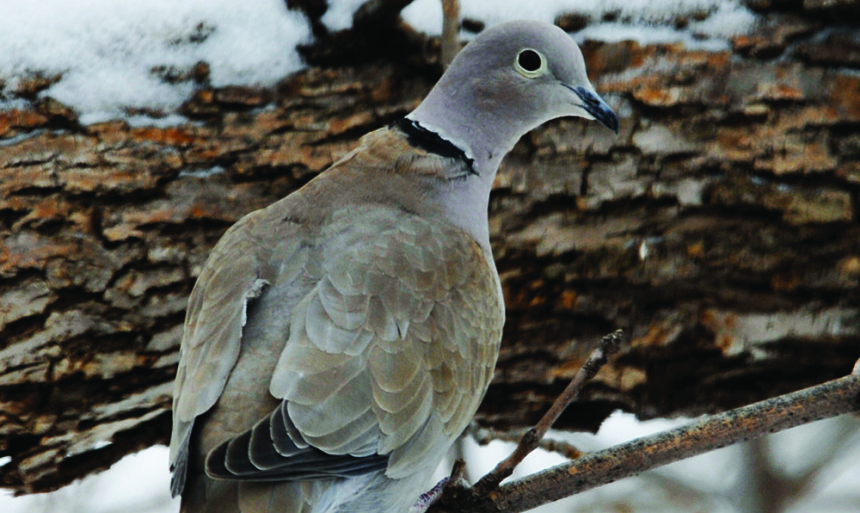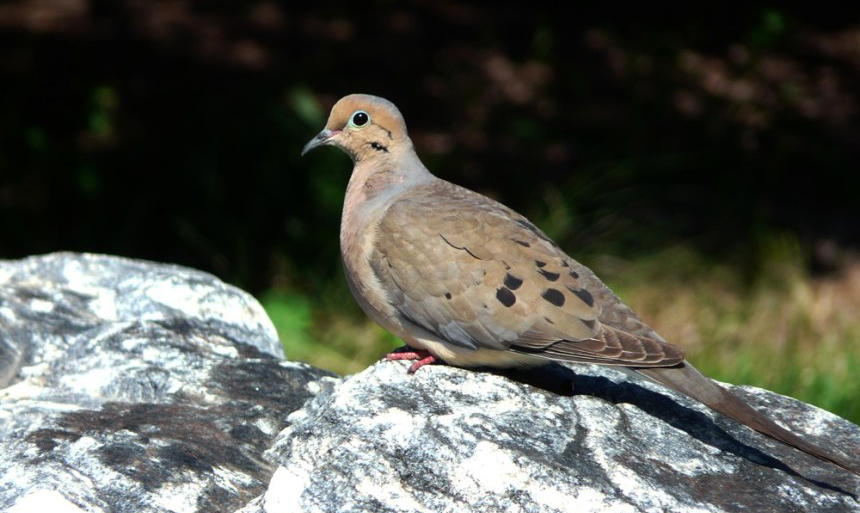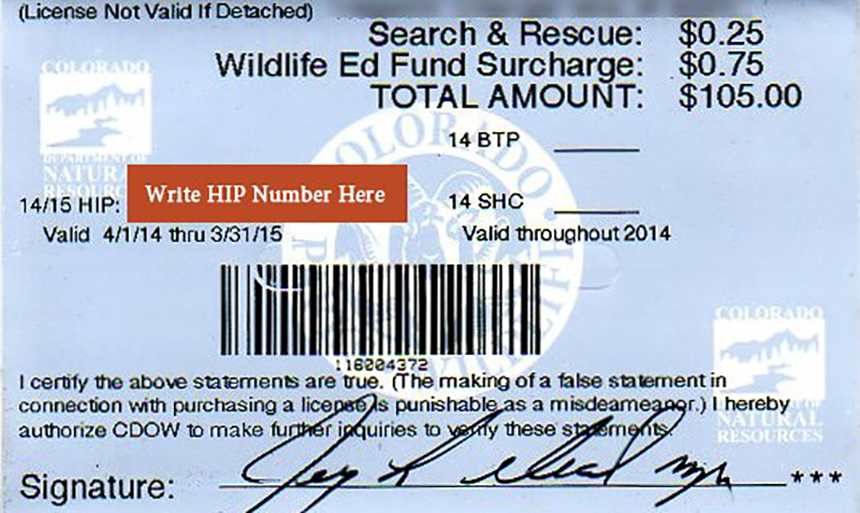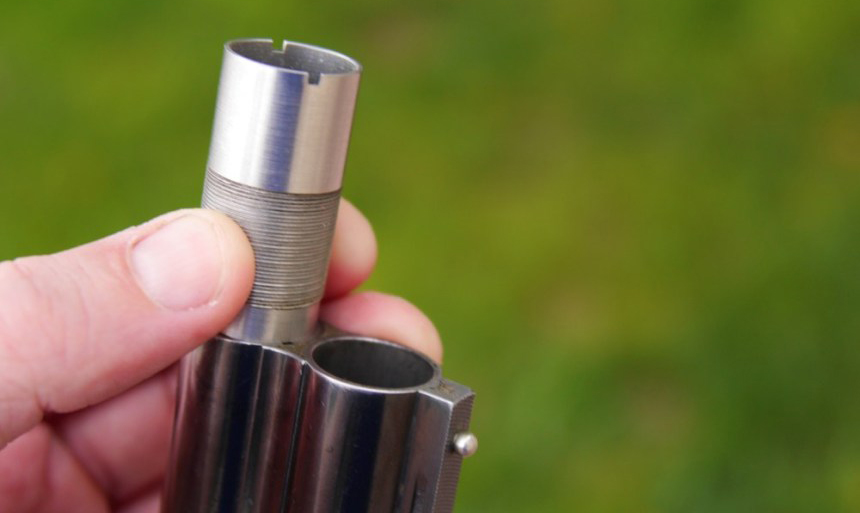1. Check out the current rules/regs brochure
The Colorado Small Game and Waterfowl brochure has helpful information for hunters. In addition to listing season dates and bag/possession limits, the brochure includes species profiles and general hunting tips.
2. Take Advantage of the Eurasian Invasion

The non-native Eurasian collared-dove is larger than a mourning dove and remains in Colorado year-round. Photo by © Wayne D. Lewis/CPW.
In addition to native mourning and white-winged doves, Colorado is now home to non-native Eurasian collared-doves (ECDs). ECDs were accidentally introduced to the United States in the 1970s when several of the birds escaped from a pet shop in the Bahamas. The birds soon made their way to Florida and, over the last four decades, have quickly spread across the Western United States and Canada.
Unlike native doves, ECDs do not migrate and stay in Colorado throughout the winter. Because the birds breed easily, wildlife managers are worried that ECDs may out-compete native species for food and habitat. To manage populations, Colorado has named ECDs an invasive species and has put in place a year-round hunting season, coupled with unlimited bag/possession limits.
Though ECDs are extremely abundant, finding the birds in places where hunting is allowed can be challenging. ECDs mostly live in urban areas and congregate at suburban bird feeders or near busy agricultural centers like feedlots and farms. However, with a little scouting of
Walk-In-Access properties, you can find localized populations of the doves in more rural settings.
The good news is that the birds are larger in size, supply more breast meat, and they don’t count toward the regular limit of mourning doves. If you can find them in the winter, ECDs provide a fun, year-round wingshooting opportunity long after the regular dove season is just a memory.
3. Hunt Early
A mourning dove. Photo by © Wayne D. Lewis/CPW.
Hunting doves in Colorado is an early season sport. Although Colorado’s dove season opens Sept. 1 and continues into November, the window of opportunity for hunters is small. Since mourning doves migrate, most of them leave the state after the first cold snap, which can happen as early as August some years.
For the best chance of success, you should hit the fields in the first days and weeks after the season opens. Depending on fall weather conditions, localized populations of doves can be found in southeast Colorado into the late season, but hunting is spotty at best. According to harvest surveys, hunters in Weld, Morgan, Adams, Arapahoe, Logan, Larimer, Yuma, Pueblo, Otero and Prowers counties harvest the greatest numbers of doves each year. And most of these birds are harvested in the early part of September.
4. Find a hunting location
More than 170,000 acres are open to dove hunting through Colorado Parks and Wildlife’s Walk-In-Access program. Although not all properties have the right habitat for doves, many areas offer good hunting opportunities.
For doves, you should do some pre-season scouting and search for areas with food crops like wheat stubble, proso-millet stubble and sunflower fields. Places near water and roosting sites (dead trees) should also hold good numbers of birds.
The
Walk-In Atlas brochure features detailed maps and GPS coordinates of enrolled properties, and includes information and tips for small-game hunters. Keep in mind that all Walk-In-Access properties are privately owned land that CPW has leased for public hunting. Please help keep these areas in good shape by picking up empty shell casings and properly disposing of harvested birds.
5. Buy your license and get your HIP #

One of the most common items that small-game hunters forget about every year is the Harvest Information Program (HIP) number.
Registering for an HIP number is fast and easy. Simply go to the Colorado HIP website or call 1-866-COLOHIP to obtain a number.
Be sure to write the HIP number in the space provided on your small-game license (see the orange bar in the image above).
The HIP helps wildlife managers set harvest estimates for doves and other migratory birds. You must have a small-game license AND an HIP Number to hunt doves and other small-game species in Colorado.
6. Don't Choke (buy the right equipment/ammo beforehand)

Using proper chokes improves shooting accuracy. Photo by © Jerry Neal/CPW.
Choosing the right choke for your shotgun is key for shooting accurately in the field. One option that works well for dove hunting is an improved cylinder and modified choke combination for a 12-gauge over/under. For the first shot, use the barrel with the improved cylinder. If needed, follow-up with a second shot using the more restrictive, modified choke. The tighter pattern of the modified choke is better at taking doves at longer distances.
Some hunters prefer a full choke on the second barrel, but it can be overkill for doves. Not only does the extremely narrow shot pattern make it more difficult to hit birds, but the condensed birdshot typically leads to badly damaged doves and breast meat.
If you’re using a shotgun without interchangeable chokes, don’t worry. Most shotguns come standard with either improved cylinder or modified barrels, which work well for most applications. Grab a box of target or skeet loads (size 7 1/2 or 8 shot) and you’re ready to go.
Field Tips:
Kevin Lansing takes cover behind trees while dove hunting at Banner Lakes State Wildlife Area (SWA). Photo by © Jerry Neal/CPW.
Standing out in the open is a bad idea if you’re trying to bag a limit of doves. You might get away with this tactic on opening morning when birds are flying low and slow. But by mid-afternoon, doves wise up and quickly learn how to avoid shotgun-wielding hunters.
Doves will sometimes dive and dodge simply reacting to a raised shotgun barrel, so it’s important to keep a low profile by crouching under trees or hiding in tall grass. Use shaded areas and vegetation to break up your silhouette. Doves sense movement more than they sense color, so keep perfectly still until you’re ready to shoot.
Unlike turkey or waterfowl hunting, you don’t need to wear full camo when hunting doves. Lightweight plaid or dull (brown or green) clothing works just fine.
Although not required for small-game hunting in Colorado, blaze-orange can be easily spotted by other hunters — a great safety feature for hunting on public lands. Wearing blaze orange let's other hunters know exactly where you are at all times. This creates safe shooting-zones and helps prevent shooting accidents.
It's better to wait to wear full camo for when you’re on private property. Even then, consider adding a little blaze orange to your outfit. Landowners will appreciate knowing your exact location, and as long as you stay hidden, you’ll still shoot plenty of doves.
Maintaining a lead is important when shooting doves. Photo composite by © Jerry Neal/CPW.
Shooting behind birds is a mistake that many beginner hunters make. Doves are strong fliers, capable of reaching speeds of more than 55 MPH, and they can fly even faster with tailwinds.
The photo above illustrates a typical crossing shot and shows you how to lead a dove. How much you lead will depend on how fast the bird is moving and the distance of your shot.
Additionally, it’s important to swing the shotgun barrel past the bird and keep your lead AFTER you’ve pulled the trigger. This is called “following through” on the shot.
One of the best ways to prepare for dove season is to spend some time on a
shooting range. Shooting fast-moving clay targets in pretend hunting scenarios will help you dust off your shotgun and improve your shooting skills before entering the field.

